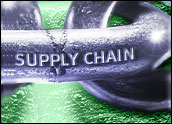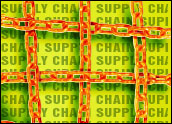
As companies evaluate their carbon footprints, supply chains are one area of business that have come under increased scrutiny. Making the complex network of manufacturers, packagers, shippers, wholesalers and retailers greener protects the environment, saves energy, and ultimately reduces costs.
Emerging technologies make it increasingly feasible to measure, manage and reduce the carbon footprint of doing business. From software that manages and evaluates the “greenness” of a company’s supply chain to electronic network systems that make communications between all the links in that chain essentially paperless, these technologies promise a greener future.
Measuring Carbon Footprints
To green a supply chain, a company must first evaluate the situation. Sometimes, this takes the form of an old-fashioned walk-through of the business by an environmental consultant or other environmental expert.
“We’ll go in and help organizations understand where they stand,” Rajeev Kapur, founder of the environmental marketing and social networking company Greenwala, told CRM Buyer. “This is what you do from a supply chain perspective. In order to be really serious, it has to be a top-down effort.”
Kapur recommends that companies hire a corporate responsibility director, chief green officer, or someone else to manage the carbon footprint of a company and its supply chain. For small companies that can’t afford such a position, however, Greenwala can help.
“We can be an extension of their team and be that chief green officer,” Kapur said.
To do a thorough investigation of a supply chain, companies can turn to software like Infor’s SCM Network Design. The latest release of this supply chain management and modeling software includes the capability of analyzing the environmental impact of a company’s supply chain. The software’s sustainability criteria let companies evaluate the carbon emissions related to the production, storage and transportation of the goods they sell.
SCM Network Design’s new environmental analysis lets companies take steps to green their supply chain by calculating these carbon emissions and present them for analysis and adjustment.
“Once a company has a benchmark for their carbon footprint, they are able to identify, using SCM Network Design’s advanced tools, how changes in the supply chain — including movement of a distribution center, shifting modes of transportation from air to rail or sourcing from different vendors — can alter the carbon impact of the supply chain,” Andrew Kinder, director of product marketing for supply chain management with Infor, told CRM Buyer. “Planners are able to do this virtually before ever making any real changes. This allows them to create several scenarios and determine which is most appropriate prior to implementing.”
Green Communication
Part of the environmental costs associated with a supply chain have to do with paper, so eliminating it in favor of digital communications between companies and their suppliers and transporters can make a big difference in the environmental impact of a supply chain. To address this issue, Verizon Business has partnered with GXS, a provider of B2B supply chain integration and collaboration products, to help clients communicate electronically with their manufacturers, distributors and shipping companies.
The end result is that companies can make their communications with their supply chain more green, and at the same time reduce error rates and save money.
“It’s a productivity play, but it also is a great green play,” Chris Kimm, Verizon’s vice president of sales engineering, told CRM Buyer. “Being smart environmentally is also smart from a productivity standpoint.”
The future of such greening communications lies in continuing advances in the electronic processing and recognition of supply chain documents.
“Much of the innovation will come in the area using artificial intelligence to learn paper formats used by trading partners,” Bill Metallo, VP of sales with Seeburger, which specializes in automating business transactions, told CRM Buyer. “This will speed up the rate that electronic partners can be enabled.”
Chain Links
Greening a supply chain is an ongoing, never-ending process, and audits are vital to this process. HP, for instance, evaluates the companies in its supply chain to monitor their carbon emissions, labor practices and other issues.
“HP regularly audits suppliers and works with suppliers on corrective action plans,” Judy Glazer, director of supply chain social and environmental responsibility for HP, told CRM Buyer. “HP has high standards for supply chain responsibility.”
Ultimately, HP follows its products all the way to the end of their lives, where, ideally, they’re reused or recycled.
“Managing [the] increasing volume of discarded equipment conserves natural resources by reducing the need for raw materials and energy to manufacture new products,” Glazer said. “As such, our commitment to responsible product reuse and recycling is integral to meeting our energy efficiency objectives.”























































